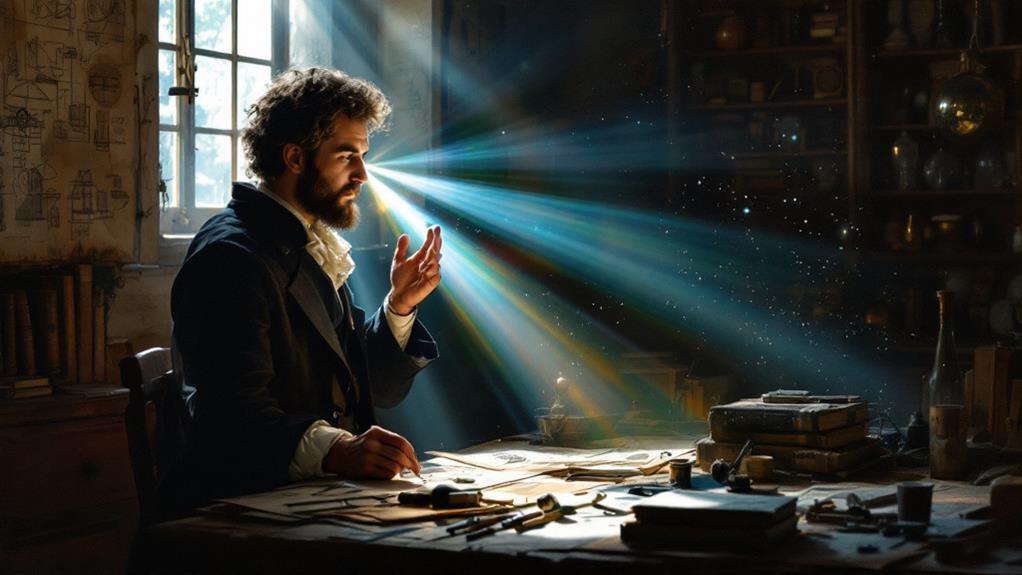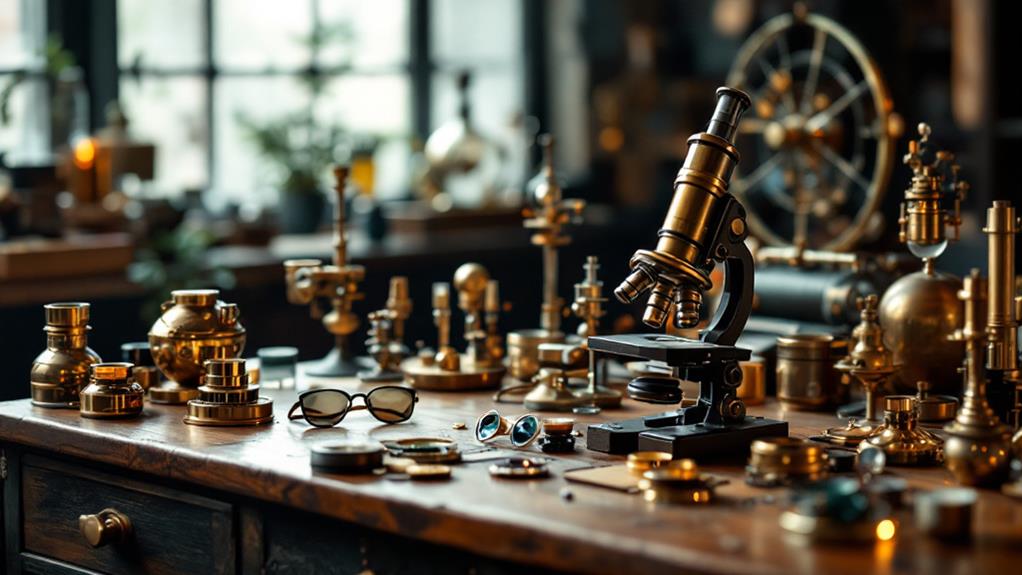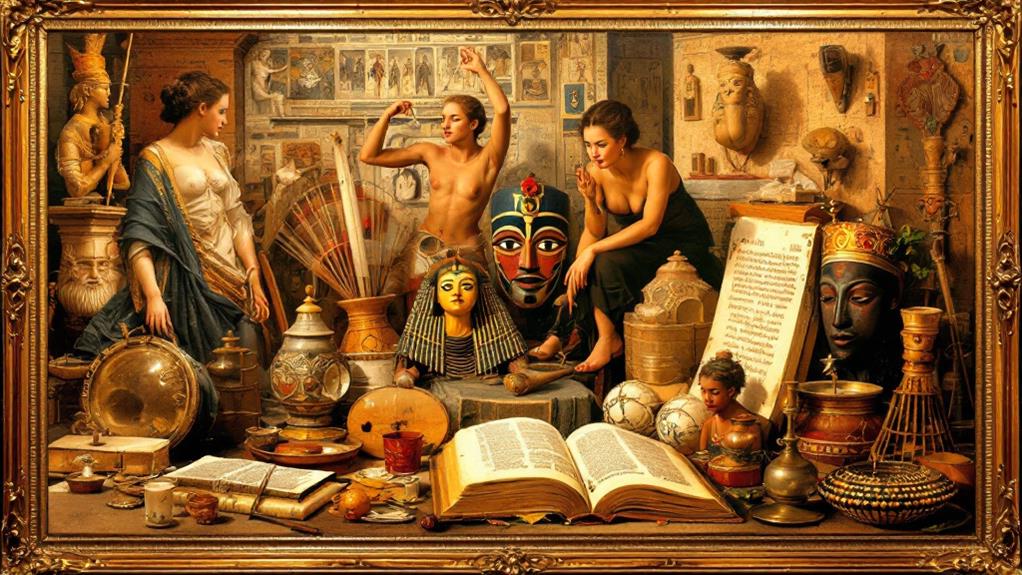The History of Optics: From Light Theories to Modern Lenses

The history of optics is a compelling excursion through time. You'll find ancient civilizations pondering the nature of light, from Greeks believing it emanated from eyes to Indians theorizing high-velocity particles. Medieval advancements brought sophisticated lenses and early spectacles, while the Renaissance saw breakthroughs in telescopes and microscopes. The Enlightenment era debated particle versus wave theories of light, and the Industrial Revolution refined lens manufacturing. Today, optics play a pivotal role in smartphones, medical devices, and telecommunications. This rich history of exploration and innovation has shaped our modern world in ways you might not expect.
Ancient Theories of Light
Three major ancient civilizations developed influential theories about the nature of light. The Greeks, Indians, and Arabs all contributed to early optical understanding, though their ideas often differed markedly from modern concepts.
In ancient Greece, you'd find competing theories about light. Empedocles believed that light emanated from the eyes, while Aristotle argued it was a disturbance in a medium. Neither fully grasped the wave-particle duality we now recognize. Meanwhile, the atomists proposed that objects emitted particles, foreshadowing later particle theories.
Indian philosophers investigated various ideas about light's nature. The Nyaya-Vaisesika school suggested light was composed of high-velocity particles, while others viewed it as a form of energy. These concepts, though incomplete, hinted at the complexity of light's true nature.
Arab scholars made substantial progress in understanding optics. Ibn al-Haytham's work on the nature of refraction was particularly innovative. He correctly deduced that light traveled in straight lines and was reflected and refracted by different media, laying the foundation for modern optical science.
Medieval Optical Advancements
While ancient civilizations laid the groundwork for optical understanding, the medieval period saw considerable advancements in both theory and practical applications. You'll find that during this time, scholars built upon earlier ideas and made substantial progress in optics.
Notable contributions came from Arab scientists like Ibn al-Haytham, who revolutionized the field with his work on light and vision. He proposed that light travels in straight lines and introduced the concept of the camera obscura. This laid the foundation for future developments in optics and photography.
In Europe, medieval monks and scholars made extensive strides in lens crafting, leading to improvements in magnifying glass design. These advancements paved the way for the creation of early spectacles, which greatly improved the quality of life for those with vision problems.
Key medieval optical advancements include:
- The development of more sophisticated lenses
- Improvements in glass manufacturing techniques
- The introduction of early spectacles
Renaissance Breakthroughs

The Renaissance ushered in a novel epoch of optical disclosure, building upon medieval foundations and propelling the field forward. You'll find that this period saw significant advancements in both theoretical understanding and practical applications of optics.
One of the most notable developments was the refinement of the camera obscura. Artists and scientists alike welcomed this device, which projected inverted images onto a surface, enhancing their ability to capture realistic scenes. You'd be amazed at how this tool influenced perspective in painting and laid the groundwork for future photographic technologies.
Johannes Kepler's contributions to optics were particularly revolutionary. He explained how the human eye works, likening it to a camera obscura, and described the process of refraction in lenses. You'll appreciate how his work on telescopes improved astronomical observations, allowing for more accurate celestial measurements.
The Renaissance also saw advancements in lens grinding techniques, leading to better eyeglasses and microscopes. These improvements enabled scientists to investigate both the vast cosmos and the microscopic world with unparalleled clarity, setting the stage for future scientific revolutions.
Enlightenment Era Discoveries
Following the Renaissance, the Enlightenment era ushered in a wave of pioneering optical innovations. You'll find that this period marked a significant shift in our understanding of light and optics. Scientists began to challenge long-held beliefs and develop new theories that would shape the field for centuries to come.
Isaac Newton's transformative work introduced the Newtonian view of light, which proposed that light consisted of tiny particles. This corpuscular theory stood in contrast to the wave theory of light, sparking intense debate among scientists. Meanwhile, René Descartes put forth his ideas on Cartesian light propagation, suggesting that light traveled through a medium of tiny particles.
The Enlightenment era brought several key advancements in optics:
- Development of achromatic lenses, reducing chromatic aberration
- Improvements in telescope design and construction
- Identification of infrared radiation by William Herschel
These discoveries laid the foundation for modern optics and paved the way for future breakthroughs. As you explore the history of optics, you'll see how these Enlightenment-era contributions continue to influence our understanding of light and its behavior today.
Industrial Revolution Innovations

Progress in optical science accelerated during the Industrial Revolution, bringing about a surge of innovations that altered both scientific understanding and practical applications. You'd have seen significant advancements in lens manufacturing techniques, enabling the production of higher-quality optical instruments for both scientific and industrial use.
Textile manufacturing advancements benefited greatly from improved microscopes, allowing for closer inspection of fibers and fabrics. These optical tools helped refine production processes and quality control in the burgeoning textile industry. Similarly, steam power applications relied on precise measurements and observations, often facilitated by enhanced optical devices.
You'd have witnessed the development of achromatic lenses, which reduced chromatic aberration and improved image quality in telescopes and other optical instruments. The invention of the spectroscope in the mid-19th century revolutionized the study of light and matter, leading to breakthroughs in fields like astronomy and chemistry.
Photography emerged as a pioneering application of optics, with the first permanent photograph produced in 1826. This innovation would go on to transform visual documentation and artistic expression, opening the door for future developments in imaging technology.
Modern Optical Technologies
Leaps in optical technology have revolutionized our world since the mid-20th century. You're now living in an era where optics play a pivotal role in everyday life, from the smartphone in your pocket to the satellites orbiting Earth. Modern optical technologies have transformed fields like medicine, telecommunications, and entertainment.
In recent years, you've seen the rise of augmented reality applications and virtual reality headsets, which blend the digital and physical worlds. These technologies rely on advanced optics to create immersive experiences, whether you're playing games or conducting remote surgeries.
Fiber optics for high-speed internet and telecommunications, laser technology for precise manufacturing and medical procedures, and advanced imaging systems for astronomy and microscopy are some key areas where modern optical technologies have made significant impacts.
You're benefiting from these innovations in ways you might not even realize. From the high-resolution screens on your devices to the cameras that capture your memories, modern optical technologies are enhancing your daily life. As research continues, you can expect even more innovative applications in fields like quantum computing and photonics, pushing the boundaries of what's possible with light manipulation.



